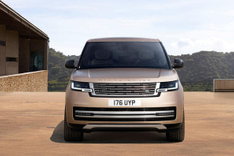The all-new, fifth-generation Range Rover is in the first stages of testing before its debut next year. This new model is one of the few that has been tasked with leading Jaguar Land Rover out of the coronavirus-induced slump that’s expected to affect the global car industry for much of this year and beyond.
Despite the closure of JLR’s production facilities and the paused launch of the new Land Rover Defender, it’s understood that there will be no let-up in the development of either the new Range Rover or the battery-electric replacement for the Jaguar XJ, which will also go on sale in international markets late next year.
According to sources, the stance of the Range Rover is set to evolve with the new model that will be based on JLR’s Modular Longitudinal Architecture (MLA). The front and rear tracks will be wider, the SUV will have more prominent wheel arches and it will sport less of a barrel-sided look than the current model. The Mk5 will get a more imperious and imposing look, which is crucial to the Range Rover’s commercial appeal.
However, the latest Range Rover’s ‘face’ might not be so different from that of the current vehicle. Cues like the wide and deep grille and Velar-style slim headlight units are expected to be retained.
The company’s new flagship will replace the current Range Rover, which debuted back in 2012, and should give JLR a much-needed high profit-margin boost just as the global economy is expected to begin emerging from the effects of the current crisis.
The fourth-generation Range Rover has been a very strong product for the company and has sold nearly 53,000 units globally last year; only a fraction down on sales in 2018. The Mk5 will again be sold in standard and long-wheelbase forms, but that’s where the direct comparisons with the current car end.
The new model will be the first Land Rover built on the MLA structure that promises to transform JLR’s competitiveness. The new platform is expected to deliver a reduction in warranty and reliability problems as well as allowing software-over-the-air (SOTA) updates. MLA can also accommodate conventional internal combustion engines, plug-in hybrid and battery-electric powertrains.
Other advantages of the MLA’s SOTA technology could include reducing the need for dealer recalls, predictive servicing that allows dealer visits to be automatically scheduled and even user-based insurance schemes. Data generated by real-world use of MLA-based vehicles will also help inform future model development, say insiders.
Unlike today’s ageing Range Rover architecture, the new MLA platform has been designed from the outset as a ‘flex-fuel’ components set. Our sister publication Autocar UK understands the fifth-gen Range Rover will make use of a BMW-sourced petrol V8 – which will be aimed at markets such as the Middle-East and California – but little other information has leaked about the other combustion engine options.
It’s known that JLR and BMW are working on developing electric motors that will be used by the MLA-based vehicles and are expected to be built at JLR’s Ingenium factory near Wolverhampton in England.
The engine facility’s switch, at least partly, to the production of electric drive modules (EDMs) suggests that JLR might adopt other BMW-sourced engines for the MLA platform. Considering the huge investment coming up for the planned Euro 7-compliant diesels, oil-burning engines could be a strong contender for a co-operative project between JLR and BMW. But the British firm is unlikely to abandon its newly launched mild-hybrid Ingenium straight-six petrol engine so soon, so expect that to also feature at the car’s launch.
Plug-in hybrid versions of the Mk5 Range Rover are expected to have one electric motor on the rear axle as well as another embedded in the transmission. It has been claimed that the electrically driven rear axle will further improve the car’s off-road ability, because of the ability to finely meter out the torque.
A pure-electric version of the Range Rover is also being considered. The model could have a battery of up to 100kWh and electric motors directly driving the front and rear wheels. However, it’s expected that any electric Range Rover would be a limited-production model targeted at city users in Asian markets. The upcoming MLA-based ‘Road Rover’ crossover is likely to be the lead Land Rover electric car.
Back in India, Land Rover currently retails the fourth-gen Range Rover in the Rs 1.97-4.09 crore (ex-showroom, pan-India) price range. The company had even revealed prices for the iconic Defender SUV that was originally slated to arrive in our market in the coming months, though that will most certainly be pushed back owing to the coronavirus crisis. Moving forward, the company is planning to add electrified models to its India line-up as well.
Also see:
2020 Range Rover Evoque launched at Rs 54.94 lakh
Land Rover Discovery Sport facelift launched at Rs 57.06 lakh
Land Rover unveils Discovery Sport and Evoque plug-in hybrids










Comments
Member Login
Personal Details
No comments yet. Be the first to comment.